From Searching for Binary Black Holes to the Nuclear Rings of Gravitational Resonance —— Every Cloud has a Silver Lining
Abstract
A research team from the Shanghai Astronomical Observatory of the Chinese Academy of Sciences has used data from the SDSS MaNGA project to conduct a study on the origins of double-peaked narrow emission-line characteristics in galactic centers. This study found that these emission lines are not only related to binary black holes but may also originate from mechanisms such as rapidly rotating gas disks and AGN outflows. In 2024, this team's statistical analysis showed that double-peaked lines are associated with galactic bars, AGN, and interactions, with the phenomena related to bars being the most common. They further revealed that the nuclear rings in barred spiral galaxies can lead to symmetrical double-peaked features in 2025. This achievement deepens the understanding of galactic center structures and provides important references for the search for binary black holes.
Double-peaked Emission Lines Are Not Always Probes for Binary Black Holes
At the end of the 20th century, astronomers observed active galactic nuclei (AGNs) at the center of galaxies using slit spectrometers and noticed peculiar ionized gas emission lines in the spectra of some targets: each emission line was composed of narrow, symmetrical double peaks, indicating the presence of two components with different velocities. This discovery immediately aroused the interest of astronomers, who speculated that the double-peaked emission line was formed by the recombination of two AGNs that revolved around each other. Specifically, in the theory of galaxy formation and evolution, mergers are important channels for galaxy growth. When the central black holes of two galaxies are very close but not merging, the narrow line regions illuminated by their respective accretion disks of AGNs can produce two separate narrow emission lines. However, due to the close proximity of the two black holes, the spatial resolutions of ground-based telescopes are generally insufficient to directly distinguish them in imaging. Therefore, the double-peaked features in galaxies was once considered the most promising probe for indirectly searching for binary black holes at the center of galaxies.
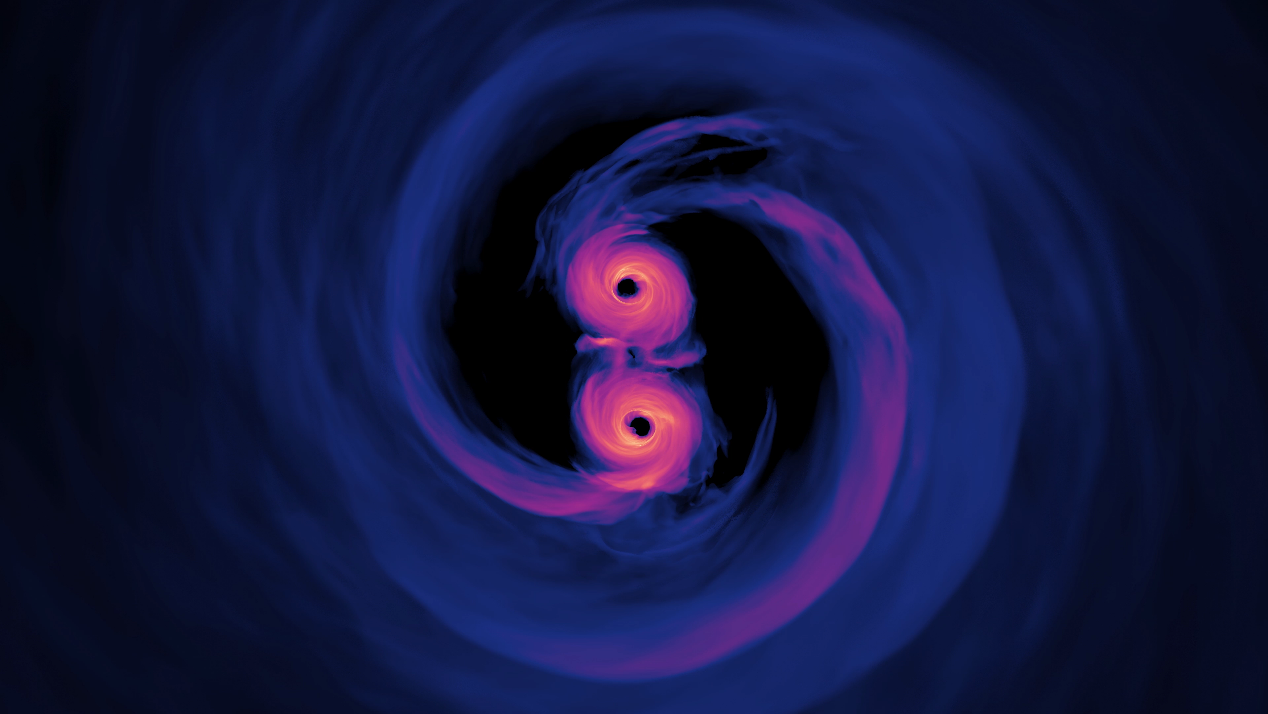
Figure 1. Simulating the full band light emitted by a binary supermassive black hole system in a transparent medium, observed from directly above the galactic disk. Credit: NASA's Goddard Space Flight Center/Scott Noble; simulation data, d'Ascoli et al. 2018
However, after decades of in-depth research, astronomers have found that the characteristics of double-peaked narrow emission lines at the center of galaxies is widespread, and its mechanism of generation is far beyond the dual AGNs rotating with each other; the high-speed rotating gas disk and the gas outflows caused by AGNs may both produce double-peaked features. In recent years, with the development of new astronomical instruments and technologies, the Integrated Field Spectroscopy (IFS) technology based on the Integrated Field Spectrometer has played a very important role in studying double-peaked narrow emission lines. Due to the fact that the IFS also provides spatially resolved spectral information of galaxies, astronomers can explore the origin of double-peaked features in galaxies by comparing the changes in their characteristics in different positions.
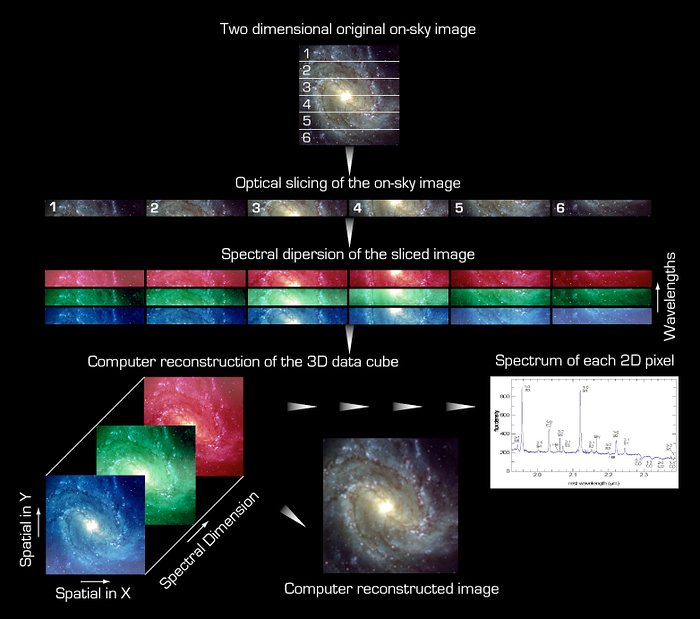
Figure 2. Principle of integrating field of spectroscopy. After the 2D image of a galaxy is divided into fields of view, spectra are generated for each field of unit. All generated spectra are arranged into a data cube, which contains the entire two-dimensional field of view and the third dimension extracted from the spectrometer. The spectrometer divides the light into different colors or wavelengths. Astronomers can use the rich information of integrated field of spectroscopy to measure, for example, the motion of gas in distant galaxies. Credit: ESO
In 2019, a joint team from the National Astronomical Observatory and the Shanghai Astronomical Observatory conducted research on a batch of double-peaked narrow emission-line galaxies discovered by the LAMOST. For the first time, they combined the IFS data from the SDSS MaNGA to explore the origin of double-peaked features at the center of the galaxy (MaNGA ID 1-556501), and inferred that its physical origin was a high-speed rotating gas disk (Wang et al. 2019). Subsequently, multiple teams have used MaNGA data to study individual cases of other galaxies, with different conclusions, including various origin mechanisms such as AGN outflows and projection effects related to interactions. In November 2024, a research team from the Shanghai Astronomical Observatory (Qiu et al. 2024) conducted a search for double-peaked narrow emission-line galaxies and statistical analysis of physical mechanisms on the IFS data of them in the MaNGA project. Due to the fact that the MaNGA project provides the largest IFS data sample of targets in the world, its research results have high statistical significance. The research results indicate that in the local universe, the double-peaked features in galaxies are related to bars, AGNs, and galaxy interactions, and these features related to bars has the highest statistical probability. This part of the work has been published in the international academic journal Astrophysics Journal.
Relation between Double-peaked Emission Lines and Central Nuclear Rings of Galaxies
Astronomers are familiar with how AGN outflows and galaxy interactions lead to two sets of emission lines, but the question of "how bars produce the double-peaked characteristics of emission lines" has never been studied seriously. One intuitive physical mechanism is whether the two different velocity components of gas, radial motion along the bar and tangential motion on the disk, will constitute the observed double-peaked narrow emission-line galaxy. This assumption was quickly ruled out because the double-peaked feature did not occur at any position of the bar, but only at the center of the barred spiral galaxy. Another possible physical origin that could lead to double-peaked features is the high-speed rotating gas disk at the center of the galaxy, as detailed below.
Under an ideal telescope with infinite spatial resolution, the gas motion at every position on a rotating disk galaxy can be resolved. So, the observed spectrum will be: a blue-shifted emission-line peak seen on the blue-shifted side of the disk, and a red-shifted emission-line peak seen on the red-shifted side. At any position, the gas has only one dominant velocity direction, thus contributing only to one peak (as shown in Figure 3). However, all telescopes in reality have a spatial resolution limit. This means that we cannot distinguish the tiny details on the disk (PSF effect). Light from a large area on the disk will be mixed together by the telescope and gathered into the same pixel or spectral element. The scale of this mixed region is much larger than that of a local area with a single velocity on the disk. In an area blurred by PSF, if there are enough gas with significant velocity differences (i.e., high-speed blue shift and high-speed red shift) simultaneously, this area will produce bright double-peaked narrow emission lines.
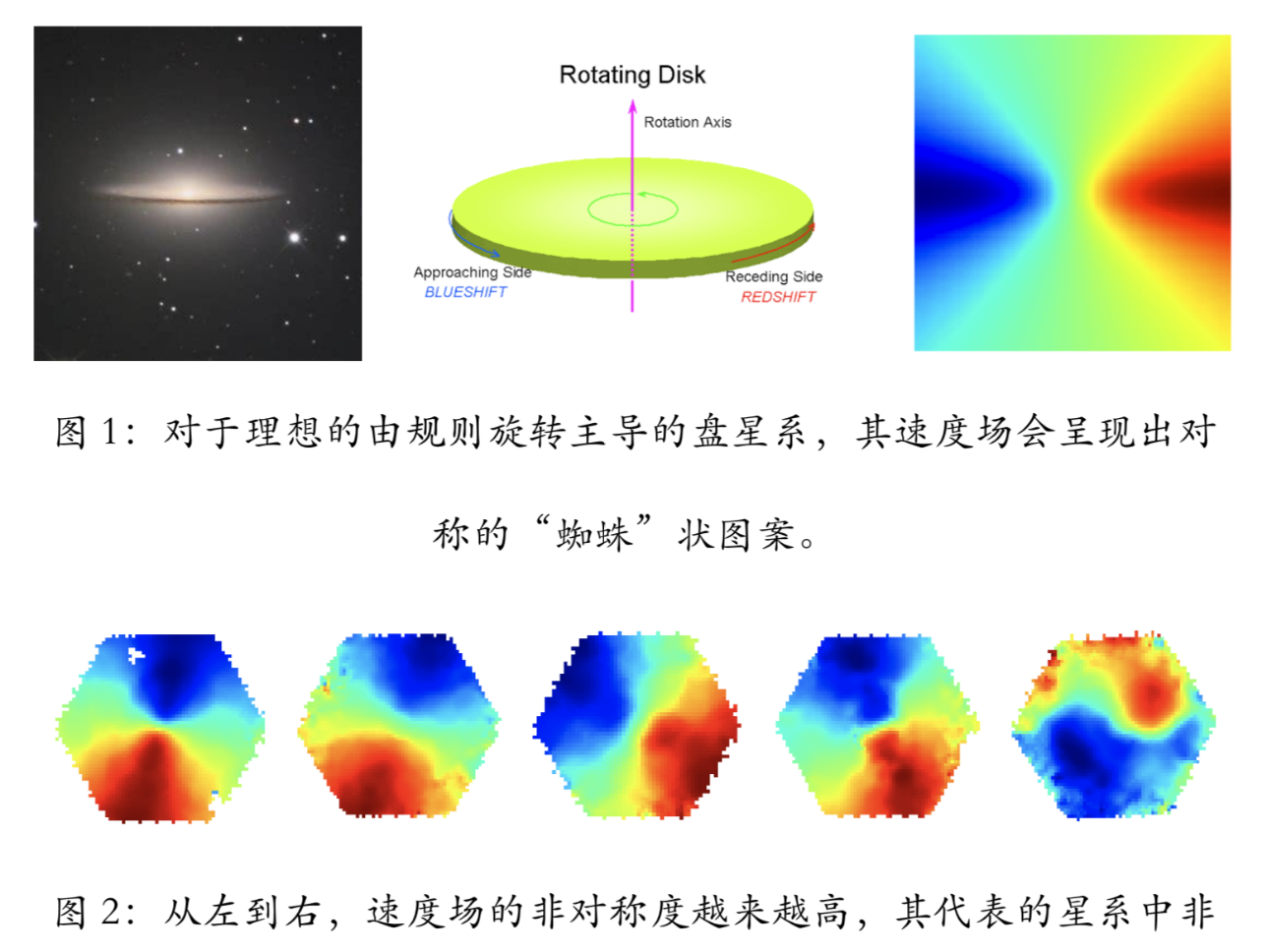
Figure 3. Feng et al. 2022 proposed an ideal disk galaxy dominated by rotation. The purple arrow represents the axis of rotation, with blue-shifted and red-shifted components on either side.
In July 2025, a research team from Shanghai Astronomical Observatory (Qiu et al. 2025) used MaNGA data on the basis of a simple galaxy rotation disk model, to propose the possibility of a symmetrical double-peaked narrow emission-line feature at the center of a galaxy caused by a nuclear ring. The nuclear ring in a barred spiral galaxy precisely satisfies this condition: the inflow gas driven by the bar gathers into the ring at the inner Lindblad resonance, producing a bright and narrow radiation region with strong rays, while it is located in a region with steep changes in the rotation curve. The scale of the nuclear ring in space is very small (indistinguishable due to PSF effect), but its rotational speed varies greatly. Therefore, in a "pixel" blurred by PSF, contributions from both the near side (high-speed blue-shifted gas) and the far side (high-speed red-shifted gas) of the ring are mixed, forming a symmetrical "double-peaked profile" (as shown in Figure 4). This part of the work has also been publicly published in the international academic journal Astrophysics Journal.
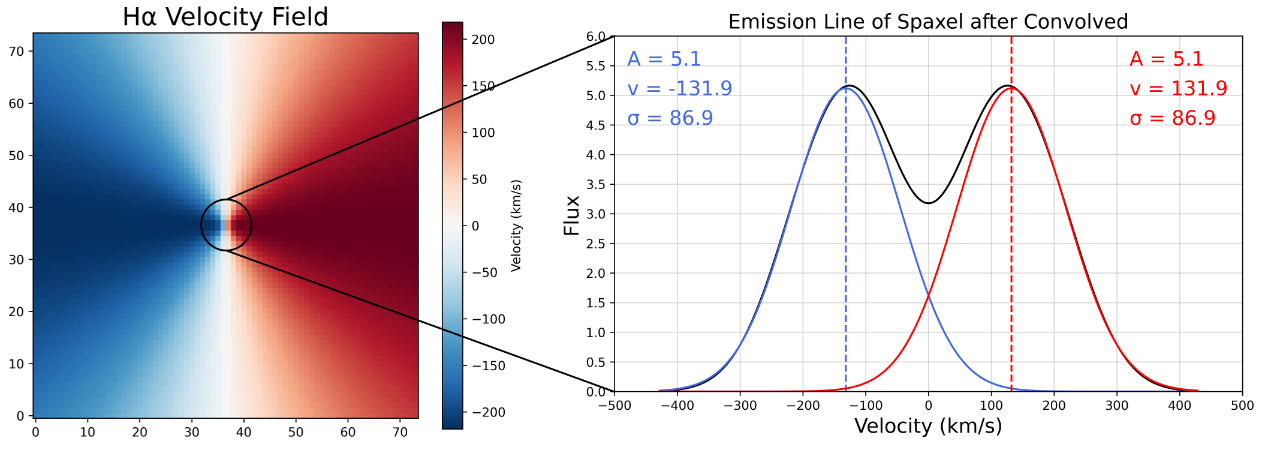
Figure 4. Under the influence of the PSF effect, a double-peaked profile is generated in the region of steep changes in the central rotation curve of a barred spiral galaxy. The blue and red contours on the right represent the fitting results of the contours, respectively.
In addition, the rotational motion of the nuclear ring is ordered and symmetrical, which directly leads to the overall symmetry of the spatial variation of the resulting double-peaked emission-line characteristics (as shown in Figure 5).
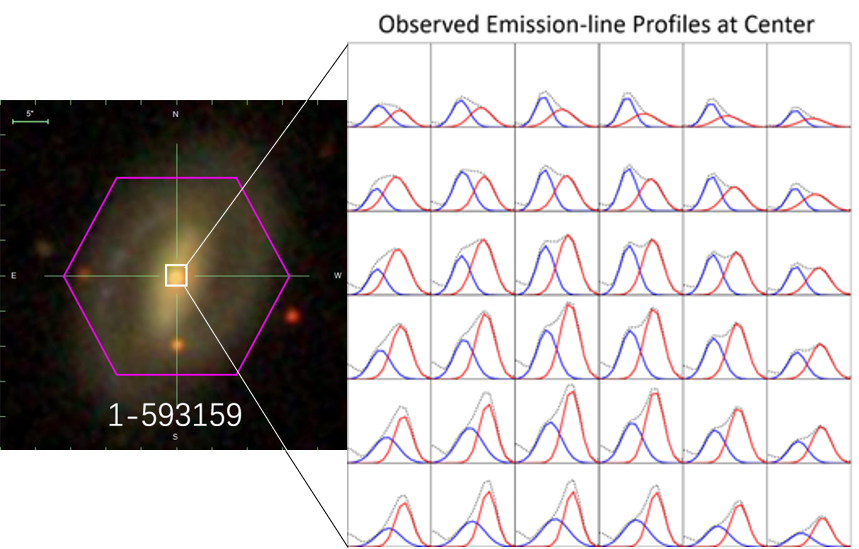
Figure 5. Regular changes in double-peaked profiles observed within the nuclear ring range of MaNGA-ID 1-593159
Finally, the value of this work lies not only in confirming a model, but also in providing strong observational evidence for "double-peaked narrow emission lines ≠ binary black holes", deepening our understanding of the central structure of galaxies, and demonstrating how instrumental effects affect scientific discoveries. When searching for elusive binary black holes, it is necessary to carefully eliminate "false positive" signals generated by structures such as nuclear rings. This forces astronomers to use higher spatial resolution observations (such as ALMA, JWST) or combine multi band information (such as X-rays to see if there are two-point sources) for confirmation.
Links to published papers:
https://iopscience.iop.org/article/10.3847/1538-4357/ad6b8e
https://iopscience.iop.org/article/10.3847/1538-4357/adf4d1
Scientific contact: Shen Shiyin, Shanghai Astronomical Observatory, Chinese Academy of Sciences, ssy@shao.ac.cn
Download attachments: